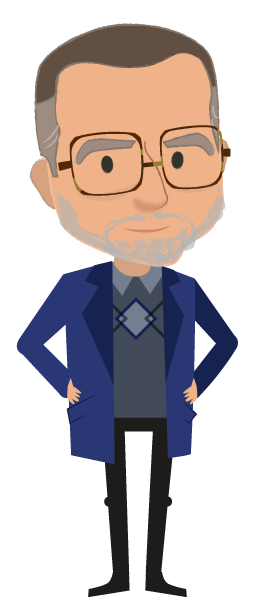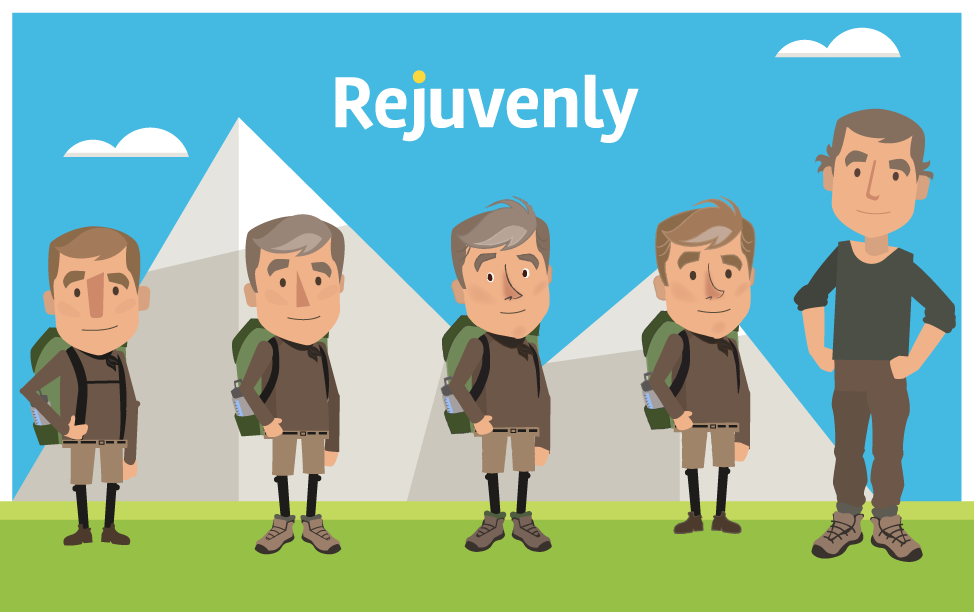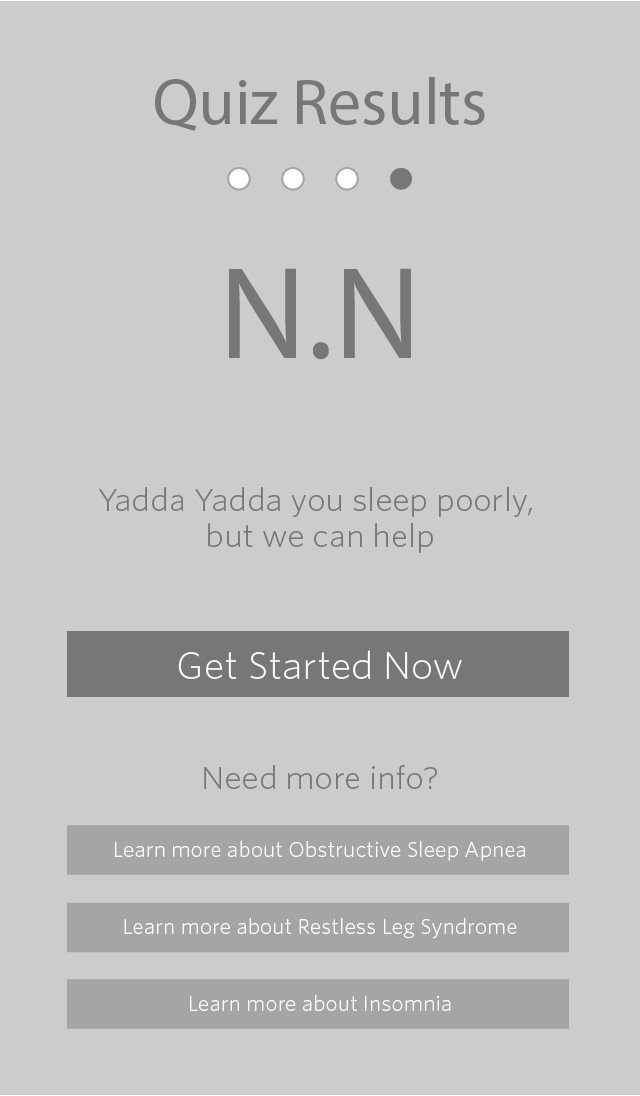Rejuvenly
Ever had a sleepless night?
Role: UX, Animation & Creative Direction
Client: Pulsar Informatics
Software: Illustrator, AfterEffects, Invision
How about several in a row? Rejuvenly is an insomnia treatment program that helps you sleep – without the use of medication. Curious? Learn how I helped developed a program to help you sleep better.
Mission: Create a sleep health program accessible to anyone with an internet connection.
Insomnia affects most adults at some point in their lives, with an estimated 30%-40% affected at any given time. 10% of the population has chronic insomnia (roughly 32,548,595 people), and an estimated 658 providers in the USA – with some states home to none.
Beyond insomnia, other conditions such as obstructive sleep apnea, restless leg syndrome, and heartburn often show up along with poor sleep. I began looking for ways to help those who slipped through the cracks.
Rejuvenly consists of two parts:
The treatment program aimed directly at people experiencing poor sleep, and the provider experience that allows direct providers and care managers to track patient progress. Although I primarily focused on the treatment program, I assisted in the design of the provider view dashboard. I’ve split the case study into two parts to showcase the different portions.
Designing the treatment program
The treatment program was two parts: The fully animated treatment program and the companion app. The animated portion of the treatment program pulls information from the companion app to determine the weekly video content. The app allows the patient to track their sleep behaviors, and follow up on instructions provided within the video content.
Discovery
I began by going through competitor’s programs – completing 3 very different approaches to CBTi over the following 6 weeks. Looking for ways to set Rejuvenly apart from these programs, I looked at how other therapies presented self-led vs. in-person treatments.

Highlights
- Individual treatments must be agile and self-led
- Extend focus beyond Insomnia
- Ignored markets include: elderly, military, shift-workers
- Missing physician oversight for patient’s progress
My solution
A patient’s success in the program depends entirely on their participation and compliance. A schedule with weekly goals are set based on the patient’s sleep log inputs from the past week, with patients given freedom to complete their tasks during the week, but must be completed before “unlocking” the next week’s content. Secondary materials would be made available during the week via the patient’s toolbox, available to be reviewed any time.
To accomplish this, we developed a webapp and companion app (native). I focused on user (patient) webapp education customization. Requirements for the companion app were handed to the UX & dev team to create.


Bring in the expert
After a few rounds of revisions, it became clear a clinical expert would be key to improving the product. Working directly with Donn, I revised the patient treatment program – and we worked out how it would be customized to fit each patient’s needs. We narrowed in on an overarching vision thanks to his expertise. Integral to the design process, Donn also ensured my graphics accurately depicted the concepts.
Welcome, Dr. Donn Posner.
Interaction design
Using a combination of animated video (primary path) and static storyboards (secondary path), I laid out a roadmap for each week’s interactions – with variables for different user’s sleep complaints and how that would feed into a seamless interaction. Designing visual bookmarks for matching between segments, as well as background music.
The end result was a smooth, interactive animated video customized to each unique user’s needs without a hint at the back end’s true complexity.
See above for one week’s interactivity flow.
Defining the Requirements
- Treatment time: 6-8 weeks minimum
- Primary method: sleep restriction plan
- Secondary material: educational pieces, anxiety reduction techniques
Visual design & animation
Designing this program was a special challenge. It meant creating a world where a patient would remain interested in the learning process, but also build the trust necessary to convince them to effect significant behavioral changes in their daily lives. I landed on an outdoor/wooded area outside of a major city. It was calm — with rolling hills and blue skies — but with added visual interest with elements like camera moves, buildings/caves/etc. as structural elements, and a variety of characters to add interest.
With two main characters: – Michael, our “sleep guide,” – a clinical- seeming character, and the “everyman,” an unnamed cabin- dwelling fellow. Other characters were created for conversations to exemplify a variety of patient- type interactions and act as an interactive FAQ.
With the help of my remote team of animators, we completed 6 weekly modules under a tight schedule. I designed simple visuals for describing complex concepts.
Visual exploration
Bonus! Some of the parts that led to the final design. It was a wild ride.

Demo video
During the early stages of development, I animated a test of the main character and some early assets – including what is referred to as ‘scratch’ voice over. This was used to further secure funding for the project. Enjoy!
Provider dashboard design
Rejuvenly Insights & Rejuvenly Clinical make up the provider dashboard of the Rejuvenly sleep treatment program, provides an access point for direct care providers as well as case managers. While direct care providers need to be able to access progress within the program as well as modifications to the treatment regimen, the case managers’ view is focused more on population health and compliance related to eligibility for payment.
How did you approach this project?
The two halves of the Rejuvenly solution were designed in tandem, although Insights was started later. By the point we were beginning the design the provider view, we already had access to several proven early adopters who were able to answer any questions as per their needs. After the user interviews were completed, I created user personas. I assessed dashboards for healthcare providers and researched the impact HIPPA requires would have on our design.
How did this research affect what was prioritized?
Research made it clear we needed to distinct dashboard types for the different users.
Those two types were split into:
RejuvenlyInsights: For care case managers, insurance billing & population health.
RejuvenlyClinical: For direct providers/doctors to track patient progress and tweak as needed.
The direct providers were often independent physicians with family practices, looking to expand their revenue streams. There are two distinct ways doctors are paid by insurance. They are either paid a flat rate to keep a population healthy, or they’re paid for direct patient treatment. For the first, the less hands-on time with a patient the more patients they can see, the more they make(ie: hands-off preventative care is incentivized). For the second, each procedure is billed directly and they see more revenue from time spent. To ensure both of these billing types found adoption of Rejuvenly beneficial, certain care plan options were designed to be billable hours- or could be left alone with limited fuss.
Early design: Where did you start?
The first area of focus was onboarding.
We needed a simple experience that allowed the provider to either hand a preloaded tablet to a patient or email a patient a link to fill in the questionnaire, depending on their care plan type. Once complete, the provider would have access to a report detailing areas for improvement, and a recommendation for next steps. If the patient was assessed with a sleep disorder, they were given access to the Rejuvenly patient program for a 6-week self-led treatment program.
There are specific clinical diagnostic surveys that were referenced in the questions with a logic tree covering symptoms of clinical insomnia, restless leg syndrome, sleep apnea, and GERD.
How did the design evolve?
Early on, we had started with the assumption that providers would send their patients an invite to the quiz via email. The idea was that it was to be self-led, opt-in. “Let’s put it all in the app!” But app-first development was already outdated as a tough sell to download an app just to take a sleep assessment, and the focus shifted to web-first development.
It wasn’t until after the sleep expert, Donn Posner, was brought on to help that the organization and logic of the final survey began to take shape.
Post design analysis: Rejuvenly (treatment & provider)
Impact:
Early trials run included the onboarding experience and the first week of the animated treatment plan. Although I don’t have the specific numbers for adoption and completion/compliance, I can say it was picked up for second and third rounds of funding from the US military under a new name.
What was successful about this project? What wasn’t?
Successes: The entire program was animated and uploaded to AWS for implementation by the development team. The overall experience was nearly seamless, and testers reported enjoying the visual explanations and “not minding” the daily work required to remain in compliance.
Areas to improve: A focus on upfront project management and clear and final buy-in from stakeholders would have saved many headaches during the development of Rejuvenly. This shift in focus would have allowed foresight into where we were missing resources that would have been crucial to speeding up development. Major program adjustments were made on the fly at the last minute, requiring significant time commitments for months at a time.
Recommendations for designers creating treatment programs
Test early, test often. Treatment programs require heavy buy-in from patients. If they’re disinterested in your content, they will quickly find themselves out of compliance. Test everything from your character to your content so you can pivot quickly before significant time has been invested.




















